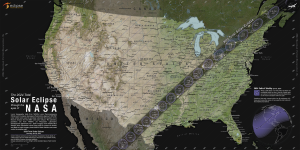By Dr. Muhammad Saleem
On Monday, April 8, a total solar eclipse—aka The Great Northern American Eclipse—will trace a narrow path of totality across 13 U.S. states, including parts of Kentucky and Indiana.
A total solar eclipse happens when the moon passes between the sun and the Earth, completely blocking the face of the sun and revealing its corona, or outer atmosphere, which is usually obscured by its brightness. For people in the moon’s shadow, called the umbra, the sky will be dark as if it is dawn or dusk.
A total eclipse is the only type of solar eclipse where viewers can momentarily remove their eclipse glasses for a brief period. It's a powerful, even life-changing experience.
People outside the area covered by the moon’s inner shadow, called the penumbra, will see a partial solar eclipse.
Louisville, which is in the penumbra, will not experience totality. But with the moon appearing to cover 98.9% of the sun, the eclipse will still be a memorable event.
The Earth experiences an eclipse season approximately twice a year when the new moon aligns so that it is positioned between the Earth and the sun. But solar eclipses do not occur every time there is a new-moon phase because the moon's orbit
is tilted about 5 degrees relative to Earth's orbit around the sun. For this reason, the moon's shadow usually passes either above or below Earth.

The Great North American Eclipse on April 8 will pass over Mexico, the USA and Canada, beginning over the South Pacific Ocean. The first location in continental North America that will experience totality is Mexico’s Pacific coast at around
11:07 a.m. PDT (2:07 pm EDT).
The path of the eclipse will continue from Mexico, entering the United States in Texas and traveling through Oklahoma, Arkansas, Missouri, Illinois, Kentucky, Indiana, Ohio, Pennsylvania, New York, Vermont, New Hampshire and Maine. Small parts of Tennessee
and Michigan will also experience the total solar eclipse.
The eclipse will exit continental North America on the Atlantic coast of Newfoundland, Canada, at 5:16 p.m. NDT (3:16 pm EDT).
In Kentucky, totality will be visible in the western part of the state, in cities like Paducah and Morganfield. The eclipse will begin at 1:42 p.m. (EDT), with totality in the west beginning around 3 p.m. and lasting for a couple of minutes.
Louisville, which is not in the path of totality, will see a partial solar eclipse, giving the sun a thin crescent shape. The partial eclipse in Louisville will start at 1:49 p.m. and end at 4:22 p.m. (EDT).
Safely Viewing the Solar Eclipse
The only time it is safe to look at the total solar eclipse with the naked eye is during the few minutes of totality. At all other times—either during the beginning and end of the total solar eclipse or during the entire partial solar eclipse—you
must view the eclipsed sun with a special filter or solar-eclipse glasses to block harmful solar radiation and protect your eyes.
Viewing the eclipse without proper precautions could cause permanent damage.
For absolutely safe direct solar viewing, solar-eclipse glasses must meet the standard for ISO 12312-2:2015, be "CE" Certified and meet the transmission requirements of scale 12-16 of EN 169/1992. These glasses are made from a scratch-resistant black
polymer material and will have an optical density of 5 or greater. They filter out 100% of harmful ultraviolet light and 100% of infrared light and 99.99% of intense visible light.
Capturing Photographs
The eclipse will be very interesting to video or photograph. But you shouldn’t take pictures or videos of a solar eclipse without a proper solar filter in front of your camera or smartphone lens. A solar filter must be used to take pictures
throughout the partial solar eclipse phases in Louisville. These solar filters reduce the sun’s radiation by a factor of 100,000.
The solar eclipse glasses you must wear to look at the sun during the partial solar eclipse in Louisville cannot protect your eyes if you are using magnification devices, such as cameras, without a solar filter. The magnification concentrates the
rays, which can damage the glasses and allow radiation to enter your eyes.
Conventional binoculars and telescopes also gather increased light and thus are dangerous to use to look at the sun for any period of time during a solar eclipse. There are solar telescopes with built-in solar filters that are safe to use for
viewing.
Muhammad Saleem, Ph.D., is an associate professor of Physics at Bellarmine University. Images courtesy of NASA.